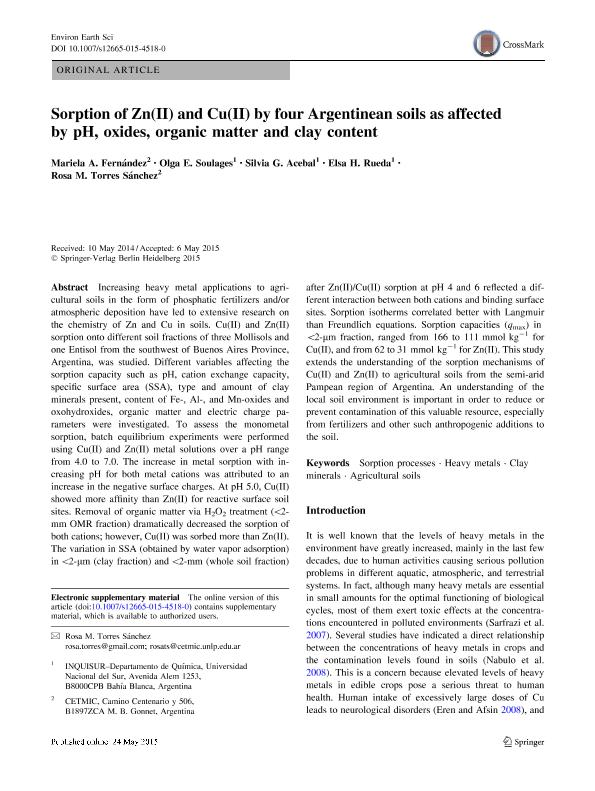Mostrar el registro sencillo del ítem
dc.contributor.author
Fernandez, Mariela Alejandra

dc.contributor.author
Soulages, Olga E.
dc.contributor.author
Acebal, Silvia Graciela

dc.contributor.author
Rueda, Elsa Haydee

dc.contributor.author
Torres Sanchez, Rosa Maria

dc.date.available
2018-06-18T18:32:44Z
dc.date.issued
2015-10
dc.identifier.citation
Fernandez, Mariela Alejandra; Soulages, Olga E.; Acebal, Silvia Graciela; Rueda, Elsa Haydee; Torres Sanchez, Rosa Maria; Sorption of Zn(II) and Cu(II) by four Argentinean soils as affected by pH, oxides, organic matter and clay content; Springer Verlag Berlín; Environmental Earth Sciences; 74; 5; 10-2015; 4201-4214
dc.identifier.issn
1866-6299
dc.identifier.uri
http://hdl.handle.net/11336/49053
dc.description.abstract
Increasing heavy metal applications to agricultural soils in the form of phosphatic fertilizers and/or atmospheric deposition have led to extensive research on the chemistry of Zn and Cu in soils. Cu(II) and Zn(II) sorption onto different soil fractions of three Mollisols and one Entisol from the southwest of Buenos Aires Province, Argentina, was studied. Different variables affecting the sorption capacity such as pH, cation exchange capacity, specific surface area (SSA), type and amount of clay minerals present, content of Fe-, Al-, and Mn-oxides and oxohydroxides, organic matter and electric charge parameters were investigated. To assess the monometal sorption, batch equilibrium experiments were performed using Cu(II) and Zn(II) metal solutions over a pH range from 4.0 to 7.0. The increase in metal sorption with increasing pH for both metal cations was attributed to an increase in the negative surface charges. At pH 5.0, Cu(II) showed more affinity than Zn(II) for reactive surface soil sites. Removal of organic matter via H2O2 treatment (<2-mm OMR fraction) dramatically decreased the sorption of both cations; however, Cu(II) was sorbed more than Zn(II). The variation in SSA (obtained by water vapor adsorption) in <2-µm (clay fraction) and <2-mm (whole soil fraction) after Zn(II)/Cu(II) sorption at pH 4 and 6 reflected a different interaction between both cations and binding surface sites. Sorption isotherms correlated better with Langmuir than Freundlich equations. Sorption capacities (qmax) in <2-µm fraction, ranged from 166 to 111 mmol kg−1 for Cu(II), and from 62 to 31 mmol kg−1 for Zn(II). This study extends the understanding of the sorption mechanisms of Cu(II) and Zn(II) to agricultural soils from the semi-arid Pampean region of Argentina. An understanding of the local soil environment is important in order to reduce or prevent contamination of this valuable resource, especially from fertilizers and other such anthropogenic additions to the soil.
dc.format
application/pdf
dc.language.iso
eng
dc.publisher
Springer Verlag Berlín

dc.rights
info:eu-repo/semantics/openAccess
dc.rights.uri
https://creativecommons.org/licenses/by-nc-sa/2.5/ar/
dc.subject
Agricultural Soils
dc.subject
Clay Minerals
dc.subject
Heavy Metals
dc.subject
Sorption Processes
dc.subject.classification
Meteorología y Ciencias Atmosféricas

dc.subject.classification
Ciencias de la Tierra y relacionadas con el Medio Ambiente

dc.subject.classification
CIENCIAS NATURALES Y EXACTAS

dc.title
Sorption of Zn(II) and Cu(II) by four Argentinean soils as affected by pH, oxides, organic matter and clay content
dc.type
info:eu-repo/semantics/article
dc.type
info:ar-repo/semantics/artículo
dc.type
info:eu-repo/semantics/publishedVersion
dc.date.updated
2018-06-18T13:28:53Z
dc.journal.volume
74
dc.journal.number
5
dc.journal.pagination
4201-4214
dc.journal.pais
Alemania

dc.journal.ciudad
Berlin
dc.description.fil
Fil: Fernandez, Mariela Alejandra. Provincia de Buenos Aires. Gobernación. Comisión de Investigaciones Científicas. Centro de Tecnología de Recursos Minerales y Cerámica. Consejo Nacional de Investigaciones Científicas y Técnicas. Centro Científico Tecnológico Conicet - La Plata. Centro de Tecnología de Recursos Minerales y Cerámica; Argentina
dc.description.fil
Fil: Soulages, Olga E.. Consejo Nacional de Investigaciones Científicas y Técnicas. Centro Científico Tecnológico Conicet - Bahía Blanca. Instituto de Química del Sur. Universidad Nacional del Sur. Departamento de Química. Instituto de Química del Sur; Argentina
dc.description.fil
Fil: Acebal, Silvia Graciela. Consejo Nacional de Investigaciones Científicas y Técnicas. Centro Científico Tecnológico Conicet - Bahía Blanca. Instituto de Química del Sur. Universidad Nacional del Sur. Departamento de Química. Instituto de Química del Sur; Argentina
dc.description.fil
Fil: Rueda, Elsa Haydee. Consejo Nacional de Investigaciones Científicas y Técnicas. Centro Científico Tecnológico Conicet - Bahía Blanca. Instituto de Química del Sur. Universidad Nacional del Sur. Departamento de Química. Instituto de Química del Sur; Argentina
dc.description.fil
Fil: Torres Sanchez, Rosa Maria. Provincia de Buenos Aires. Gobernación. Comisión de Investigaciones Científicas. Centro de Tecnología de Recursos Minerales y Cerámica. Consejo Nacional de Investigaciones Científicas y Técnicas. Centro Científico Tecnológico Conicet - La Plata. Centro de Tecnología de Recursos Minerales y Cerámica; Argentina
dc.journal.title
Environmental Earth Sciences
dc.relation.alternativeid
info:eu-repo/semantics/altIdentifier/doi/http://dx.doi.org/10.1007/s12665-015-4518-0
dc.relation.alternativeid
info:eu-repo/semantics/altIdentifier/url/https://link.springer.com/article/10.1007%2Fs12665-015-4518-0
Archivos asociados
